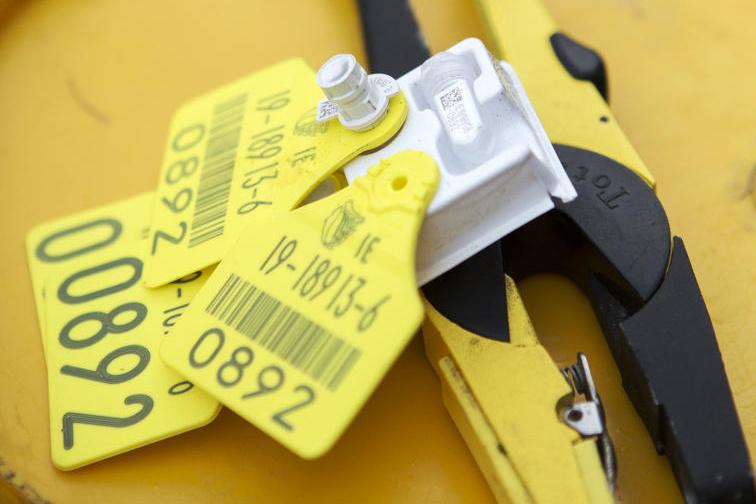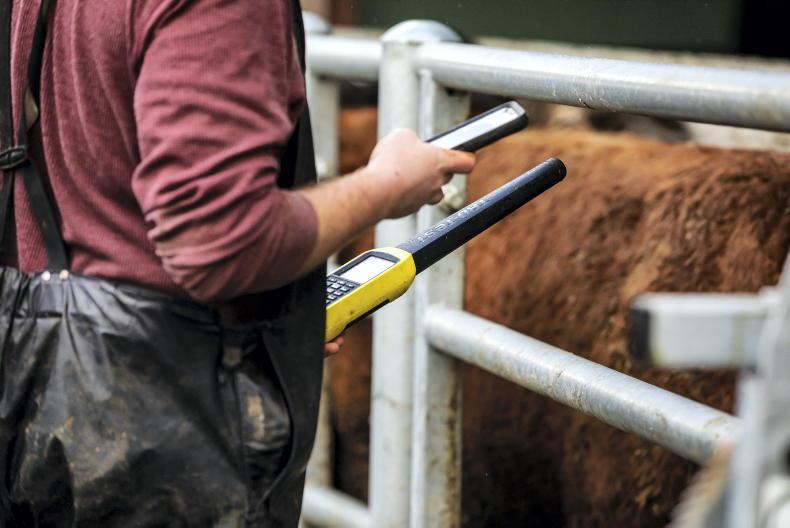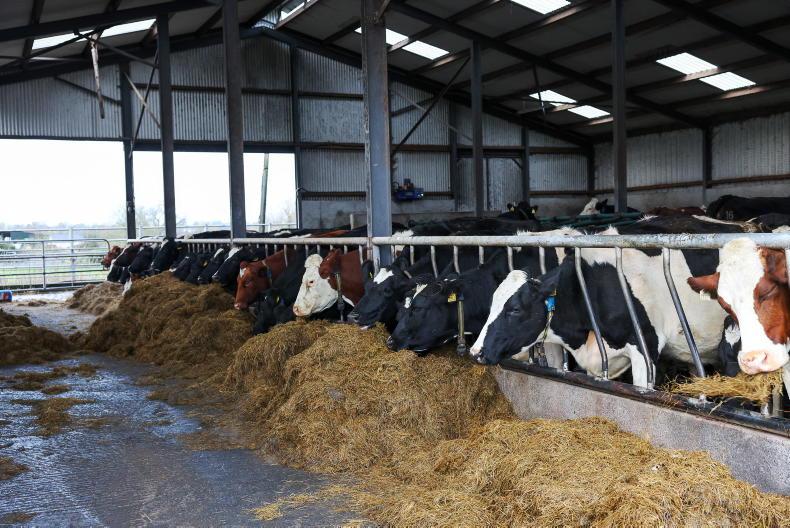Electronic identification (EID) tags have been around for a good number of years. They have primarily been used for the identification of cows in hi-tech milking systems and for automatic drafting.
Traditionally, EID tags were available as a standalone product – a button-like tag very similar in size and shape to the BVD tags or the genomics tags. Each of these tags had a unique code.
When this code is entered into a milking parlour or automatic drafting gate software, alongside the cow’s tag or freezebrand number, then the cow can be identified electronically. This usually happens when a cow walks past an antenna board on entering the parlour or drafting gate.
The advantages of automatic identification for drafting gates is obvious, but for milking parlours, it depends largely on the level of automation in the parlour.
Milking parlours with feed-to-yield feeding systems and built-in electronic milk recording meters will require the cows to be identified.
If identification is not automated through EID tags or neck collars, then the cows must be identified manually by punching her number in to the control panel at each milking unit.
Other mainstream uses for EID tags on dairy farms is for out-of-parlour feeders in intensive high-input farms that feed a lot of meal.
They are also now widely used to identify calves for automatic calf feeders, so the computer knows which calf is at the feed station and whether or not the calf is due a feed.
Mullinahone Co-op and Cormac Tagging have been selling standalone EID tags for a number of years. Mullinahone sells the Allflex range of EID tags, which are manufactured in France, for €5.58 each, while Cormac sells the Caisley range, manufactured in Germany, for between €1.80 and €3.20 each.
Since 2014, Mullinahone Co-op has been offering the option of an integrated EID and official animal identification tag for an extra €1 per tag set. For this, the farmer gets the tissue sample tag and EID tag either together or on separate tags.
In the new pricing regime, Mullinahone is offering the EID and tissue tag along with the official animal identification tag set for €3.95, including the 38c contribution to the ICBF, which is €1.05 greater than the ordinary tag set.
The other official cattle tag supplier, Cormac Tagging, is offering the same package for the same price. Its EID tags are slightly different to the one being offered by Mullinahone, but both work in the same way and are compatible with all milking machines, drafting gates and other devices that use EID tags. The Cormac EID tag costs €1.27 more than the ordinary tag set.
The big advantage of the integrated EID and cattle tag is that it saves the need to tag an animal twice. The other big advantage is the cost saving over standalone EID tags.
The reason why standalone EID tags are so much more expensive than the integrated tag is not fully understood. Effectively they do the same thing but the standalone EID tag is reusable by cutting off the male part and reusing the female part on a different animal. Of course, the standalone EID tag is not just available from the two official tag suppliers. They are also sold by other companies including milking machine suppliers.
One of the drawbacks that may arise from buying the EID tag integrated with the official tag is that, on most dairy farms, it is only female animals that need to be identified electronically.
If buying all EID tags, you will be paying extra for tagging male calves that may be sold. Some farmers with automatic calf feeders will use ordinary cattle tags on the male calves and cable-tie button EID tags on, which can be removed and used again when that calf is sold or weaned.
Other uses
But it is not just for identifying animals in milking parlours, drafting gates and calf feeders that EID tags are useful; they have a range of other uses also.
Portable EID tag-reading devices can now be purchased that will read the tag numbers of the animals when they are within range. Depending on the product and the specification, there are many things that it can do with this information.
In Teagasc Moorepark, the research farms there are equipped with portable computers that have built-in antennas for reading the tag numbers of cows. Records such as liveweight or body condition scores can then be inputted into the handheld device while on the farm and downloaded to a computer back at the office later.
They are also used by the technicians when blood-sampling – the barcodes on the blood vials can be synched with the tag number of the cow, which speeds up the recording process and reduces errors such as recording the wrong tag number.
Less sophisticated and lower-cost EID tag readers are also available that will read the tag number and either store this information or send it to another device.
There are a number of portable stick-type readers on the market. These will read the animal’s tag number and send it via bluetooth to another device such as a bluetooth-enabled weigh indicator or an app on a phone or a tablet. Other information such as body condition score or breed can also be stored on the stick reader.
These devices are particularly useful when dealing with large numbers of stock.
It is also possible to install fixed tag readers on a crush and link this to a weigh indicator or other device. The big advantage is that you are not spending time trying to find the cow’s number, which can be difficult and slow, especially when tags get dirty.
Other forms of EID are also available, such as neck bands and foot straps. These are usually combined with other technology, such as electronic heat detection aids and pedometers, so they are usually considerably more expensive than just the EID tag.
As a form of basic identification, they offer no real advantages over the EID ear tag. Many farmers will reuse the button-type ear tag when a cow is being sold.
Read more from our special focus on animal identification
Watch: Mullinahone’s cattle tag is now stronger
New tagging option for cattle farmers
Datamars already supplying cattle tags in NI
How to tag calves safely
Electronic tags – what’s it all about?
Freeze-branding - is it still worthwhile?
Genomics: What? Why? How?
Most sheep penalties caused by sheep census
Different tagging systems and prices north and south
BVD tagging guidelines north and south
Electronic identification (EID) tags have been around for a good number of years. They have primarily been used for the identification of cows in hi-tech milking systems and for automatic drafting.
Traditionally, EID tags were available as a standalone product – a button-like tag very similar in size and shape to the BVD tags or the genomics tags. Each of these tags had a unique code.
When this code is entered into a milking parlour or automatic drafting gate software, alongside the cow’s tag or freezebrand number, then the cow can be identified electronically. This usually happens when a cow walks past an antenna board on entering the parlour or drafting gate.
The advantages of automatic identification for drafting gates is obvious, but for milking parlours, it depends largely on the level of automation in the parlour.
Milking parlours with feed-to-yield feeding systems and built-in electronic milk recording meters will require the cows to be identified.
If identification is not automated through EID tags or neck collars, then the cows must be identified manually by punching her number in to the control panel at each milking unit.
Other mainstream uses for EID tags on dairy farms is for out-of-parlour feeders in intensive high-input farms that feed a lot of meal.
They are also now widely used to identify calves for automatic calf feeders, so the computer knows which calf is at the feed station and whether or not the calf is due a feed.
Mullinahone Co-op and Cormac Tagging have been selling standalone EID tags for a number of years. Mullinahone sells the Allflex range of EID tags, which are manufactured in France, for €5.58 each, while Cormac sells the Caisley range, manufactured in Germany, for between €1.80 and €3.20 each.
Since 2014, Mullinahone Co-op has been offering the option of an integrated EID and official animal identification tag for an extra €1 per tag set. For this, the farmer gets the tissue sample tag and EID tag either together or on separate tags.
In the new pricing regime, Mullinahone is offering the EID and tissue tag along with the official animal identification tag set for €3.95, including the 38c contribution to the ICBF, which is €1.05 greater than the ordinary tag set.
The other official cattle tag supplier, Cormac Tagging, is offering the same package for the same price. Its EID tags are slightly different to the one being offered by Mullinahone, but both work in the same way and are compatible with all milking machines, drafting gates and other devices that use EID tags. The Cormac EID tag costs €1.27 more than the ordinary tag set.
The big advantage of the integrated EID and cattle tag is that it saves the need to tag an animal twice. The other big advantage is the cost saving over standalone EID tags.
The reason why standalone EID tags are so much more expensive than the integrated tag is not fully understood. Effectively they do the same thing but the standalone EID tag is reusable by cutting off the male part and reusing the female part on a different animal. Of course, the standalone EID tag is not just available from the two official tag suppliers. They are also sold by other companies including milking machine suppliers.
One of the drawbacks that may arise from buying the EID tag integrated with the official tag is that, on most dairy farms, it is only female animals that need to be identified electronically.
If buying all EID tags, you will be paying extra for tagging male calves that may be sold. Some farmers with automatic calf feeders will use ordinary cattle tags on the male calves and cable-tie button EID tags on, which can be removed and used again when that calf is sold or weaned.
Other uses
But it is not just for identifying animals in milking parlours, drafting gates and calf feeders that EID tags are useful; they have a range of other uses also.
Portable EID tag-reading devices can now be purchased that will read the tag numbers of the animals when they are within range. Depending on the product and the specification, there are many things that it can do with this information.
In Teagasc Moorepark, the research farms there are equipped with portable computers that have built-in antennas for reading the tag numbers of cows. Records such as liveweight or body condition scores can then be inputted into the handheld device while on the farm and downloaded to a computer back at the office later.
They are also used by the technicians when blood-sampling – the barcodes on the blood vials can be synched with the tag number of the cow, which speeds up the recording process and reduces errors such as recording the wrong tag number.
Less sophisticated and lower-cost EID tag readers are also available that will read the tag number and either store this information or send it to another device.
There are a number of portable stick-type readers on the market. These will read the animal’s tag number and send it via bluetooth to another device such as a bluetooth-enabled weigh indicator or an app on a phone or a tablet. Other information such as body condition score or breed can also be stored on the stick reader.
These devices are particularly useful when dealing with large numbers of stock.
It is also possible to install fixed tag readers on a crush and link this to a weigh indicator or other device. The big advantage is that you are not spending time trying to find the cow’s number, which can be difficult and slow, especially when tags get dirty.
Other forms of EID are also available, such as neck bands and foot straps. These are usually combined with other technology, such as electronic heat detection aids and pedometers, so they are usually considerably more expensive than just the EID tag.
As a form of basic identification, they offer no real advantages over the EID ear tag. Many farmers will reuse the button-type ear tag when a cow is being sold.
Read more from our special focus on animal identification
Watch: Mullinahone’s cattle tag is now stronger
New tagging option for cattle farmers
Datamars already supplying cattle tags in NI
How to tag calves safely
Electronic tags – what’s it all about?
Freeze-branding - is it still worthwhile?
Genomics: What? Why? How?
Most sheep penalties caused by sheep census
Different tagging systems and prices north and south
BVD tagging guidelines north and south










SHARING OPTIONS